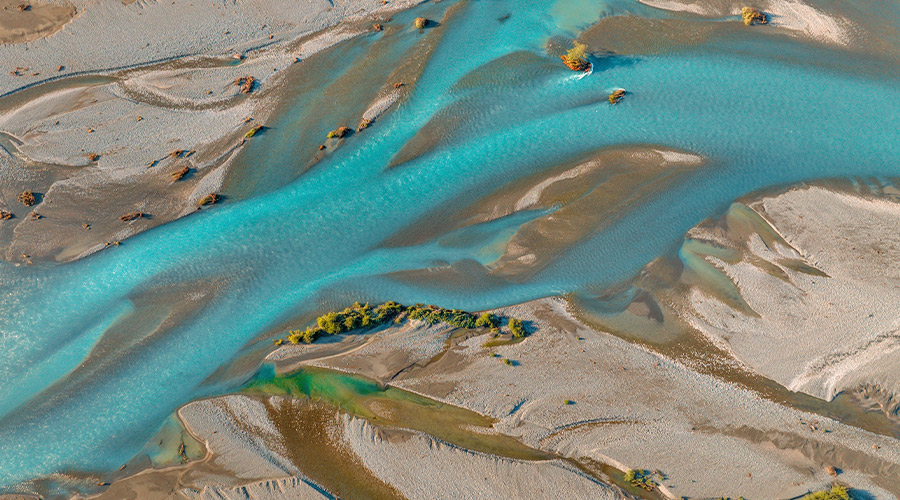Activities in and around braided riverbeds
This guidance aims to help provide some certainty on what is and what is not a 'riverbed' in Canterbury for the purposes of the Resource Management Act (RMA) and our plans.
It is designed to help any party with responsibilities related to river management and resource use under the Resource Management Act (RMA), the Canterbury Land and Water Regional Plan (LWRP) and the Flood Protection and Drainage (FPD) Bylaw.
What are braided rivers?
Braided rivers are unique ecosystems, providing outstanding habitat for many rare birds, fish, plants and other species.
A key part of their makeup is driven by their multiple, shifting channels and banks, varying flows, variety of habitats, and their ability to move over the landscape.
The natural character of these rivers is a primary concern for the community and preserving it was singled out as one of the key targets in the Canterbury Water Management Strategy (CWMS).
Determining the 'bed' of a river
To meet our communities’ aspirations and for us and territorial authorities to understand our respective responsibilities for the management of these rivers and their margins, we need to be clear on what constitutes the ‘bed’ of a braided river in terms of the RMA and the LWRP rules.
Under the RMA
The RMA defines the 'bed' of a river as "the space of land which the waters of the river cover at its fullest flow without overtopping its banks".
The most important step in determining the RMA 'bed' is to first identify the relevant 'banks'. These are the banks which contain the land "covered by water during the ordinary rainy season", but which "exclude flows or inundations arising from major storms".
This is often difficult in braided rivers due to the multiple shifting channels and banks that characterise these systems.
In most cases, the best approach to identify the riverbanks is to use the area of gravel kept relatively clear of vegetation by frequent freshes as a starting point.
After identifying that area, the closest distinguishable 'banks' to that area – typically outside/at the edge of the gravel – are likely to be the banks for the purpose of the RMA. (Note: Where there is no clear bank, but there are clear banks upstream and downstream, it is reasonable to join the banks with an imaginary line, especially if this coincides with the edge of the gravel). The area between these banks would then be considered the bed of the river in terms of the RMA.
While this method is relatively simple and cost-effective, it does not work in many riverbed areas as banks can be indistinct and difficult to identify. The nature of braided rivers also means that where the bank is located can change rapidly as a result of natural river processes. In these situations, a more detailed case-by-case assessment is likely to be required. We recommend contacting us for assistance and guidance via our contact us page or call us on 0800 324 636.
Under the LWRP
The LWRP specifies riverbed rules across an area of both RMA land and RMA riverbed to recognise the FPD Bylaw and its role in the protection of flood protection assets.
If you are on a river where the FPD Bylaw applies, you will need LWRP resource consent to undertake works between the bylaw lines.
If you are not on a river where the FPD Bylaw applies, you will need resource consent only to do work within the RMA bed. However, you will need to check whether other rules (e.g., vegetation clearance) apply.
The FPD Bylaw is applicable to areas and assets specifically mapped in the bylaw.
How does this relate to consenting rules?
We are aware that there is confusion on the legal requirements related to activities in and around riverbeds.
While this page provides some guidance on how to start identifying the bed of a river, we are also aware that the changeable nature of braided rivers means this can be difficult.
We advise anyone thinking of undertaking works (e.g., farming intensification, earthworks, structures or vegetation clearance) near any riverbed, but particularly a braided one, to proceed cautiously and talk to us and/or the relevant territorial authority (district council and regional council) before they do anything.
This will help to:
- clarify the riverbed edge at the outset
- identify sensitive environments (e.g., presence of wetlands within river margins or culturally significant areas) that you should be aware of
- identify any resource consents you might need (from us or the territorial authority)
- highlight any potential environmental issues or policy around intensification and development of our valuable braided river environment.
More information
- If you have further queries, please contact us, or call us on 0800 324 636.
- Find out more about the resource consent process.
- Find out more about the flood protection and drainage bylaw.
- Braided rivers - Canterbury's iconic treasures.
- Our unique ecosystems.

